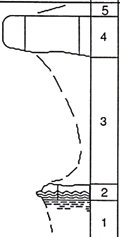
|
| Unit No. |
Description |
Thickness |
|
5
|
Covered
|
|
|
4
|
Crinoid wackestone, gray, with abundant fusulinids towards top, many brachiopods
|
0.75 - 1 ft.
|
|
3
|
Covered. Contains abundant float (lenses?) of crinoid wackestone, gray, with abundant fusulinids and brachiopods
|
2.6 ft.
|
|
2
|
Peloid, alga boundstone, gray to red brown; upper surface encrusted by Spirorbis worm, foram, alga boundstone,2 milimeters to 1 centimeter thic, porous, with eroded edges and truncated upper surface; overlain and underlain by foram, ostracode packstone to wackestone, light gray, with loose Calcivertella forams about 15% and ostracodes about 10% of rock, many very fine- quartz-sand grains and gastropods, upper part contains few crinoids and brachiopod fragments, lower part ( underlying peloid, alga boundstone) contains tiny pebble-sized intraclasts of peloid, alga boundstone and 4 milimeters thick by 6 centimeters wide peloid-algal(?) lenses. Peloid, algal boundstone morphology: 6 centimeters high, laterally linked columnal to domal features, flat topped, seperated about every 10 centimeters by channel rills about 1 centimeter wide and 4 centimeters deep, with ragged edges. Rills and larger pores are generally filled with foram, ostracode packstone. A dark gray shale to mudstone fills the upper part of some large pores. Domal features (2 centimeter inner height) are visible only on the basal surface of the 6 centimeter thick layer of peloid, alga boundstone
|
0.32 ft.
|
|
1
|
Shale, yellow to tan
|
|
|


